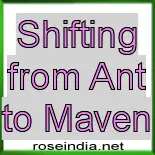Shifting from Ant to Maven
Maven is entirely a different creature from Ant. Ant is simply a toolbox whereas Maven is about the application of patterns in order to achieve an infrastructure which displays the characteristics of visibility, reusability, maintainability, and comprehensibility. It is wrong to consider Maven as a build tool and just a replacement for Ant.
Ant Vs Maven
There is nothing that Maven does that Ant cannot do. Ant gives the ultimate power and flexibility in build and deployment to the developer. But Maven adds a layer of abstraction above Ant (and uses Jelly). Maven can be used to build any Java application. Today JEE build and deployment has become much standardized. Every enterprise has some variations, but in general it is all the same: deploying EARs, WARs, and EJB-JARs. Maven captures this intelligence and lets you achieve the build and deployment in about 5-6 lines of Maven script compared to dozens of lines in an Ant build script.
Ant lets you do any variations you want, but requires a lot of scripting. Maven on the other hand mandates certain directories and file names, but it provides plugins to make life easier. The restriction imposed by Maven is that only one artifact is generated per project (A project in Maven terminology is a folder with a project.xml file in it). A Maven project can have sub projects. Each sub project can build its own artifact. The topmost project can aggregate the artifacts into a larger one. This is synonymous to jars and wars put together to form an EAR. Maven also provides inheritance in projects.
Maven : Stealing the show
Maven simplifies build enormously by imposing certain fixed file names and acceptable restrictions like one artifact per project. Artifacts are treated as files on your computer by the build script. Maven hides the fact that everything is a file and forces you to think and script to create a deployable artifact such as an EAR. Artifact has a dependency on a particular version of a third party library residing in a shared remote (or local) enterprise repository, and then publish your library into the repository as well for others to use. Hence there are no more classpath issues. No more mismatch in libraries. It also gives the power to embed even the Ant scripts within Maven scripts if absolutely essential.



